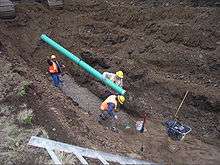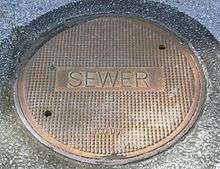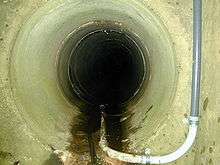Sanitary sewer

A sanitary sewer or "foul sewer" is an underground carriage system specifically for transporting sewage from houses and commercial buildings through pipes to treatment facilities or disposal. Sanitary sewers are part of an overall system called a sewage system or sewerage.
Sewage may be treated to control water pollution before discharge to surface waters.[1][2] Sanitary sewers serving industrial areas also carry industrial wastewater.
Separate sanitary sewer systems are designed to transport sewage alone. In municipalities served by sanitary sewers, separate storm drains may convey surface runoff directly to surface waters. Sanitary sewers are distinguished from combined sewers, which combine sewage with stormwater runoff in one pipe. Sanitary sewer systems are beneficial because they avoid combined sewer overflows.
Background
Sewage treatment is less effective when sanitary waste is diluted with stormwater, and combined sewer overflows occur when runoff from heavy rainfall or snowmelt exceeds the hydraulic capacity of sewage treatment plants.[3] To overcome these disadvantages, some cities built separate sanitary sewers to collect only municipal wastewater and exclude stormwater runoff collected in separate storm drains. The decision between a combined sewer system or two separate systems is mainly based on need for sewage treatment and cost of providing treatment during heavy rain events. Many cities with combined sewer systems built prior to installing sewage treatment have not replaced those sewer systems.[4]
Types
Conventional gravity sewers




In the developed world, sewers are pipes from buildings to one or more levels of larger underground trunk mains, which transport the sewage to sewage treatment facilities. Vertical pipes, usually made of precast concrete, called manholes, connect the mains to the surface. Depending upon site application and use, these vertical pipes can be cylindrical, eccentric or concentric. The manholes are used for access to the sewer pipes for inspection and maintenance, and as a means to vent sewer gases. They also facilitate vertical and horizontal angles in otherwise straight pipelines.
Pipes conveying sewage from an individual building to a common gravity sewer line are called laterals. Branch sewers typically run under streets receiving laterals from buildings along that street and discharge by gravity into trunk sewers at manholes. Larger cities may have sewers called interceptors receiving flow from multiple trunk sewers.[6]
Design and sizing of sanitary sewers considers the population to be served over the anticipated life of the sewer, per capita wastewater production, and flow peaking from timing of daily routines. Minimum sewer diameters are often specified to prevent blockage by solid materials flushed down toilets; and gradients may be selected to maintain flow velocities generating sufficient turbulence to minimize solids deposition within the sewer. Commercial and industrial wastewater flows are also considered, but diversion of surface runoff to storm drains eliminates wet weather flow peaks of inefficient combined sewers.[7]
Force mains
Pumps may be necessary where gravity sewers serve areas at lower elevations than the sewage treatment plant, or distant areas at similar elevations. A lift station is a sewer sump that lifts accumulated sewage to a higher elevation. The pump may discharge to another gravity sewer at that location or may discharge through a pressurized force main to some distant location.[6]
Effluent sewer
Effluent sewer systems, also called septic tank effluent drainage (STED) or solids-free sewer (SFS) systems, have septic tanks that collect sewage from residences and businesses, and the effluent that comes out of the tank is sent to either a centralized sewage treatment plant or a distributed treatment system for further treatment. Most of the solids are removed by the septic tanks, so the treatment plant can be much smaller than a typical plant. In addition, because of the vast reduction in solid waste, a pumping system can be used to move the wastewater rather than a gravity system. The pipes have small diameters, typically 1.5 to 4 inches, or 4 to 10 cm. Because the waste stream is pressurized, they can be laid just below the ground surface along the land's contour.
Simplified sewer
Simplified sanitary sewers consist of small-diameter pipes (typically 100 mm or about 4 inches), often laid at fairly flat gradients (1 in 200). The investment cost for simplified sanitary sewers can be about half the cost of conventional sewers. However, the requirements for operation and maintenance are usually higher. Simplified sewers are most common in Brazil and are also used in a number of other developing countries.
Vacuum sewer
In low-lying communities, wastewater may be conveyed by vacuum sewer. Pipelines range in size from pipes of six inches (150 mm) in diameter to concrete-lined tunnels of up to thirty feet (10 m) in diameter. A low pressure system uses a small grinder pump located at each point of connection, typically a house or business. Vacuum sewer systems use differential atmospheric pressure to move the liquid to a central vacuum station.
Maintenance
Sanitary sewer overflow can occur due to blocked or broken sewer lines, infiltration of excessive stormwater or malfunction of pumps. In these cases untreated sewage is discharged from a sanitary sewer into the environment prior to reaching sewage treatment facilities. To avoid this, maintenance is required.
The maintenance requirements vary with the type of sanitary sewer. In general, all sewers deteriorate with age, but infiltration and inflow are problems unique to sanitary sewers, since both combined sewers and storm drains are sized to carry these contributions. Holding infiltration to acceptable levels requires a higher standard of maintenance than necessary for structural integrity considerations of combined sewers.[8] A comprehensive construction inspection program is required to prevent inappropriate connection of cellar, yard, and roof drains to sanitary sewers.[9] The probability of inappropriate connections is higher where combined sewers and sanitary sewers are found in close proximity, because construction personnel may not recognize the difference. Many older cities still use combined sewers while adjacent suburbs were built with separate sanitary sewers.
For decades, when sanitary sewer pipes cracked or experienced other damage, the only option was an expensive excavation, removal and replacement of the damaged pipe, typically requiring street repavement afterwards. In the mid-1950s a unit was invented where two units at each end with a special cement mixture in between was pulled from one manhole cover to the next, coating the pipe with the cement under high pressure, which then cured rapidly, sealing all cracks and breaks in the pipe.[10] Today, a similar method using epoxy resin is used by some municipalities to re-line aging or damaged pipes, effectively creating a "pipe in a pipe". These methods may be unsuitable for locations where the full diameter of the original pipe is required to carry expected flows, and may be an unwise investment if greater wastewater flows may be anticipated from population growth, increased water use, or new service connections within the expected service life of the repair.
Another popular method for replacing aged or damaged lines is called pipe bursting, where a new pipe, typically PVC or ABS plastic, is drawn through the old pipe behind an "expander head" that breaks apart the old pipe as the new one is drawn through behind it.
These methods are most suitable for trunk sewers, since repair of lines with lateral connections is complicated by making provisions to receive lateral flows without accepting undesirable infiltration from inadequately sealed junctions.
History
Sanitary sewers evolved from combined sewers built where water was plentiful. Animal feces accumulated on city streets while animal-powered transport moved people and goods. Accumulations of animal feces encouraged dumping chamber pots into streets where night soil collection was impractical.[11] Combined sewers were built to use surface runoff to flush waste off streets and move it underground to places distant from populated areas. Sewage treatment became necessary as population expanded, but treatment of diluted waste from combined sewers is more expensive than treating undiluted sewage.
See also
References
- ↑ Metcalf, Leonard; Eddy, Harrison P. (1922). Sewerage and Sewage Disposal: A Textbook. New York: McGraw-Hill.
- ↑ Staley, Cady; Pierson, George S. (1899). The Separate System of Sewerage, Its Theory and Construction. New York: Van Nostrand.
- ↑ Report to Congress: Impacts and Control of CSOs and SSOs (Report). Washington, D.C.: U.S. Environmental Protection Agency (EPA). August 2004. p. ES-2. EPA-833-R-04-001.
- ↑ Metcalf & Eddy, Inc. (1972). Wastewater Engineering: collection, treatment, disposal. New York: McGraw–Hill. p. 119.
- ↑ Tilley, E., Ulrich, L., Lüthi, C., Reymond, Ph., Zurbrügg, C. (2014) Compendium of Sanitation Systems and Technologies - (2nd Revised Edition). Swiss Federal Institute of Aquatic Science and Technology (Eawag), Duebendorf, Switzerland. ISBN 978-3-906484-57-0.
- 1 2 American Society of Civil Engineers and Water Pollution Control Federation Design and Construction of Sanitary and Storm Sewers (1969) pp.2&288
- ↑ Tyler, Richard G. (1959). Civil Engineering Handbook. Section 9 (Fourth ed.). New York: McGraw-Hill. pp. 1–24.
- ↑ Hammer, Mark J. Water and Waste-Water Technology (1975) John Wiley & Sons ISBN 0-471-34726-4 p.442
- ↑ Steel, E.W. and McGhee, Terence J. Water Supply and Sewerage (1979) McGraw-Hill ISBN 0-07-060929-2 p.22
- ↑ "Sewer Sealing Machine Patches Cracks Underground." Popular Mechanics, April 1956, p. 86.
- ↑ "The History of Toilets". Mary Bellis. Retrieved 2013-12-16.
| Wikimedia Commons has media related to Sanitary sewer. |
